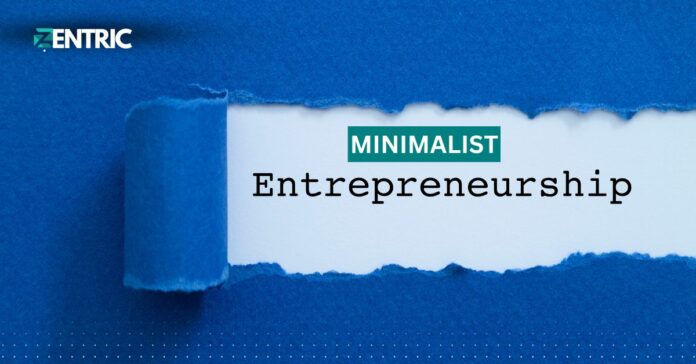Entrepreneurship for most people these days is the desire for economic liberation from the stinginess of regular life, expression of creativity, and autonomy. But traditional models of business call for substantial initial investments of capital, wide-scale planning, and complex management structures. Minimalist entrepreneurship is an oasis in this desert.

Minimalist entrepreneurship is all about creating a business on a tight budget, using clever methods to minimize expenses while maximizing profits. It’s all about being efficient, low-profile, and sustainable so that an entrepreneur works only on what is needed—delivering value to customers without unnecessary hassles.
Understanding Minimalist Entrepreneurship
Minimalist entrepreneurship is driven by the minimalism values, where one achieves more with less. Instead of going for huge investments, elaborate office space, and a huge team, minimalist entrepreneurs operate with lean organizations, web-based tools, and a strong individual brand. This enables them to start small, test quickly, and scale up without burning out or being trapped in financial woes.
A minimalist entrepreneur cares more about efficiency than expansion, quality more than quantity, and sustainability more than high expansion. This paradigm is particularly worth it for solo entrepreneurs, freelancers, and small businesspersons who want to build successful ventures without undue stress and risk.
The Fundamental Principles of Minimalist Entrepreneurship
The origins of minimalist entrepreneurship are in simplicity, frugality, and profitability. Entrepreneurs embracing this philosophy focus on a handful most critical things:
1. Lean Startup Mindset: Instead of spending months or years working on a business plan, minimalists boot up quickly with an MVP. This allows them to test concepts, receive feedback, and refine their products at low expense.
2. Bootstrapping Instead of Raising Capital: Traditional businesses draw on venture capital or borrowing, which are sources of pressure on fast expansion. Lean business owners prefer bootstrapping—using personal capital, small investment, or profit gained from initial sales.
3. Low Overhead Costs: Office rentals, full-time employees’ hiring, and excessive expenses are energy sapping for a business. Lean entrepreneurs focus on keeping costs at bay by working from home, outsourcing some actions, and avoiding repetitive steps.
4. Smart Use of Technology Tools: Technology lies at the heart of minimalist entrepreneurship. Social media promotion and website platforms, automation through AI and task management tools are some examples of digital tools that help entrepreneurs manage businesses effortlessly without requiring enormous teams.
5. Customer-Centric Approach: Instead of creating elaborate business models, minimalist entrepreneurs focus on solving a specific problem for a well-defined target audience. Through excellent customer understanding, they can offer practical solutions with minimal unnecessary complexity.
Steps to Build a Low-Cost, High-Profit Minimalist Business
Identifying a Profitable Niche
The initial step in minimalist entrepreneurship is to find a niche that is consistent with your passion, skill, and demand in the market. Rather than focusing on a large number of people, minimalist entrepreneurs successful in their venture look at a specific group with a precise pain point.
Market research, competitor profiling, and customer interactions can help you list down your niche. Look for opportunities where you can provide a unique value proposition with minimal capital requirements.
Creating a Minimum Viable Product (MVP)
Rather than waiting for the ideal product or service, go live with a basic MVP that is valuable. This may be an eBook, an online course, a consulting business, a digital product, or a software prototype. The aim is to validate the market using minimal resources and get feedback prior to investing heavily.
Leveraging Digital Marketing for Growth
Minimalist entrepreneurs rely considerably on internet marketing strategies to reach their target audience without spending significant sums of money on traditional advertisement. Content marketing, social media engagement, email marketing, and search engine optimization (SEO) are all critical drivers for achieving brand visibility at minimal costs.

By giving continually valuable content, engaging with fans, and optimizing for organic reach, entrepreneurs can gain a loyal customer base without relying on expensive ad campaigns.
Automation and Outsourcing
Automation helps entrepreneurs save time and streamline processes. Tools like Zapier, ChatGPT, HubSpot, and Notion help entrepreneurs automate workflow, customer support, and marketing.
Outsourcing is also among the major characteristics of minimalist entrepreneurship. Instead of hiring full-time employees, minimalist entrepreneurs outsource workers as freelancers and virtual assistants on a project basis. Upwork, Fiverr, and Freelancer websites make it easy to access qualified professionals without having to sign up for long-term engagements.
Monetizing Your Business Efficiently
A minimalist businessperson ensures that every effort generates revenue. Instead of relying on multiple revenue streams that require significant management, they focus on a single or double highly profitable models such as:
• Selling digital products (templates, courses, eBooks)
• Subscription-based services
• Affiliate marketing
• Consulting and coaching
• Freelancing
By leveraging pricing strategies, upselling existing customers, and maintaining good customer relationships, entrepreneurs can ensure there is consistent revenue growth with less expense.
Minimalist Entrepreneurship Challenges and Solutions
While minimalist entrepreneurship is full of benefits, it is not a trouble-free strategy. The following are some common pitfalls and their solutions:
1. Lean Start up Capital: Bootstrapping needs patience and sensible money handling. Start with affordable tools and re-invest profits wisely.
2. Wearing Multiple Hats: Since there are no employees or partners, as a one-man operation, it can be extremely demanding. Streamline operations, automate if possible, and outsource if unavoidable.
3. Slow Growth: Minimalist companies tend to grow organically, which can take time. Build strong customer relationships and deliver superior value to speed up growth.
4. Market Competition: Standing out in a competitive market requires a unique selling proposition (USP). Define what makes your product or service different and communicate it effectively.
5. Work-Life Balance: Independent entrepreneurs might find it challenging to maintain work-life balance. Establish limits, plan breaks, and prevent burnout by having efficient workload management.
Conclusion
Minimalist entrepreneurship is a radical method for individuals who want to develop a low-expense, high-profit business without excessive sophistication. With lean management, digital technology, and customer-focused strategies, business owners can develop enduring success without dependent investments.
This attitude allows entrepreneurs to work smarter, not harder, and every effort counts towards profitability and growth. Whether you are beginning a side hustle, going full-time into entrepreneurship, or expanding an existing business, embracing minimalist beliefs can allow you to achieve financial freedom without sacrificing a good quality of life.
FAQs
1. What is minimalist entrepreneurship?
Minimalist entrepreneurship is an inexpensive business model with a focus on lean organizations, digital solutions, and simple structures in order to maximize profits efficiently.
2. How do I begin a minimalist business with zero capital?
Start with free digital spaces, offer services instead of products, utilize social media marketing, and plough early profits into growth.
3. Which are the most lucrative business ideas for minimalists?
The greatest ideas are digital products, online courses, freelance services, affiliate marketing, and subscription businesses.
4. How can I keep business costs low?
Work remotely, utilize automation tools, outsource some tasks, avoid unnecessary expenditures, and focus on revenue activities.
5. Is minimalist entrepreneurship universal?
While it is beneficial to those who are simplicity- and freedom-loving, it is not necessarily for those seeking rapid growth or ginormous-sized operations.



